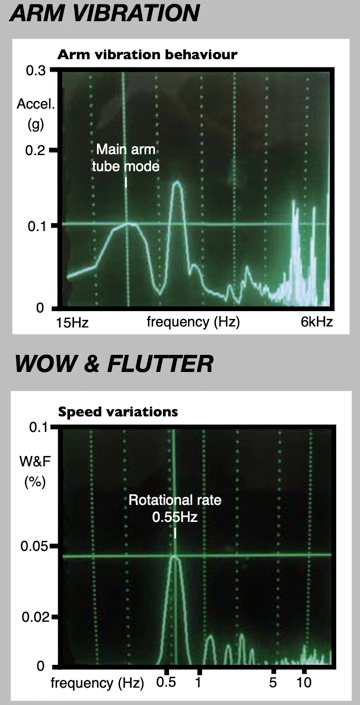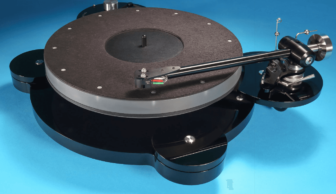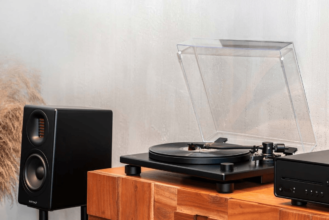TEAC TN-5BB Review
Teac fit their new TN-5BB turntable package with balanced outputs. Noel Keywood explains why. Read our TEAC TN-5BB Review.
“A beautifully built and finished Teac turntable.” I thought to myself after unpacking. Then I turned it around and looked at its rear. Oh!

Balanced outputs. Teac’s TN-5BB turntable has a more attractive rear than the name, that’s for sure – if you dream about using a balanced turntable.
That’s unlikely – but you should. Because for technical reasons that would fill a small book, turntables should be connected in a balanced fashion to banish hum and noise, giving a washed-clean sound. Few are.
Looking at the big XLR sockets at the rear told me what Teac was thinking about when designing the TN-5BB. But this is a topic I will cover in detail later; there’s plenty more of interest.
It looks like a standard belt drive – a “drive it yourself” two-speed, but the TN-5BB is a three-speed with 78rpm as an option. Add in a bayonet-fixing SME-style removable headshell for a quick change to a 78rpm cartridge, and it will appeal to die-hards able to survive seeing their 78s shatter.

More surprising was an electronic lift/lower system that worked beautifully in dependable Teac style. Place arm over record, touch the big button up front, and it lowers smoothly. Yep, they’ve fitted a motorised lift/ lower platform and it worked so well I used it, rather than my usually more reliable fingers.
Better, at the end of a side, the turntable detects arm run-out and triggers the lift platform to raise the arm and stop the turntable. This gives end-of-side silence: no tick-pop until you get off the settee. How civilized! The trouble is that moving the arm back to its rest actuated the arm movement sensor, needlessly restarting the platter; I stopped it by switching the speed control to 0. Peculiar behavior, I thought, but then I realized the speed had to be set to zero when the platter was stationary.
Whilst this belt-drive turntable looks like many others, it has some strong distinguishing features. The d.c. the motor is electronically controlled, so changing speed is simply turning the rotary speed selector from 0 to 33,45, or 78 at the front. No need to fiddle with the belt. However, as confirmed by our measurements, the platter has a sensor to keep speed accurate and tightly controlled.

The power supply is a small external wall-wart style switchmode delivering in 12V/ 1A. Using a low d.c. voltage from an external supply means the turntable does not have to be safely earthed to the mains, eliminating hum – a now-popular design approach. It leaves the metalwork electronically ‘floating’ and must be earthed to the amplifier using a supplied black earth cable.
Removing the TN-5BB from its box presented an array of parts, including a clear acrylic platter, belt, power supply, 45rpm adaptor, hinges for the dear acrylic dust cover, and hex keys for arm adjustment. Also packed separately was the headshell with an Ortofon 2M Red moving magnet (MM) cartridge installed, avoiding the need for alignment. However, Teac also includes an alignment gauge. Similarly, the counterweight must be fished out of its giddy hole and screwed onto the rear of the arm.

More unusual than these parts were a push-on pulley cover that must be carefully aligned so the belt doesn’t scrape and a set of packing washers to increase the height of the adjustable feet, should one or perhaps two need it. The feet on our sample were very tight and needed jiggling to free them. You don’t get a 45rpm depression or anywhere-to-store parts, an arm lock, or balanced cables. Teac supplies normal phono (unbalanced) cables only.
The tracking force for the 2M Red was quoted as 1.8gm in the User Manual, but Ortofon quoted the 1.6gm- 2gm range, and I used the latter.

The Red used to be quite a bright-sounding MM lacking traditional warmth, but Ortofon has tamed it to lessen this. What you get is detail rather than warmth.
Putting it all together showed me how solid and well-made the TN-5BB is. The dual-layer plinth comprises an MDF base with a synthetic marble top, separated by a Washi paper layer, Teac says, for the best sound quality. The plinth is heavy, weighting 8.8 kg. The overall weight of the turntable is 10.5kg (23.2 lbs), and it feels rigid, that’s for sure, needing a strong shelf or support surface. While the plinth depth is 350mm, considering the lid rear overhang when open, consider it around 400mm. The plinth width is 450mm, and the height without the lid is 150mm, but with it, at least 430mm is needed between shelves when open.

The arm is developed by the Japanese company SAEC. It uses knife edge bearings for vertical movement, but ball races for lateral (like old SMEs such as the 3009). The arm is an alloy tube that felt and sounded undamped and a bit ringy to me, but its S shape detunes the first bending mode to keep structural resonances in check, measurement showed. Its height can be adjusted, as can the height of the cue platform.
TEAC TN-5BB SOUND QUALITY
First peculiarity. In their literature, Teac says only that a balanced connection is for MC cartridges. And that’s it – there’s no elaboration. Since an MM cartridge is fitted and conventional phono leads supplied, initially, I used it as anyone might, unbalanced into our Creek Voyage i20 amplifier driving Martin Logan ESL-X hybrid electrostatic loudspeakers.
But musing on this, I could not help feeling users might wonder why the XLR sockets can’t be used with the cartridge fitted or even what they are for. And what about changing over from MM, which the kids use, to Dad’s precious MC? Change the leads as well?

It turns out that after checking the earthing system with a meter, you can connect it up to balance it with the cartridge supplied or any other MM. It connects the cartridge screening can to one signal line (Left ground, green) but this is no disaster – and apart from this you get fully balanced working with MM that will eliminate hum, buzz, ground currents et al. Well, that’s the theory. The problem is that there is only one phono stage that offers a balanced connection for MM, Pro-Ject’s Phono Box RS2. Teac’s PE-505 does not – likely why Teac doesn’t mention using MM balanced. More on this later.
To review this turntable, I realized that the budget 2M Red could usefully be upgraded to 2M Black with its better stylus and also that it should be connected to our Phono Box RS2 to provide balanced working. Then, I had to change to Teac’s PE- 505 for MC. Running a balanced turntable unbalanced is rather missing the point, after all.

With the Ortofon 2M Red fitted, connected with the phono cables supplied, I got much of the expected sound from previous experience. This cartridge is now accurate in tonal balance, meaning it lacks the warmth of old MMs, being more open and revealing. Yet without high-end spit from the stylus, ticks and pops don’t fly out like bullets, making treasured old LPs playable.
I can’t say “detailed” because the elliptical stylus sounded slightly blurred, and this demanded a change to the 2M Black stylus with its Shibata profile. At this point, I found our Black stylus did not comfortably fit this Red unit, so the whole cartridge was changed. It brought an immediate and significant improvement, the 2M Black with Shibata stylus imposing focus and solidity to the Trondheim Soloists behind Marianne Thorsen, playing Mozart violin concertos. Not only were strings less mellifluous – individual violins rather than a blob of them – but the performance seemingly came to life.

Next, it was time to switch to MM, which is balanced working. Before doing this, turning the volume to the maximum with unbalanced, there was a slight buzz at full volume even though the earthing was perfect. Moving to balance with the Pro-Ject Phono Box RS2, one channel went silent, but the other still had a very slight buzz, if much reduced. This came from the screening can connected to the right channel (green) ground, which I found by removing the stylus assembly and touching it. So, they can pick up external noise, but it was barely audible and balanced with MM, which was slightly quieter and better.
I noticed two other issues at full volume (which introduced massive gain from the Creek). The arm was slightly microphonia lifting it put handling noises through the ‘speakers, and the phono sockets (now unused) were ‘live’.Touching either puts a massive buzz through the speakers because they are fully floating and connected to the XLR lines. It is not ideal, but as the left channel remained silent at full volume, these floating sockets were not injecting hum or buzz, unlike the floating screening can. Note that I’m talking about very low levels of buzz here, which are inaudible at normal listening levels.

So onto MC. I strapped in our Ortofon Cadenza Bronze. Switching to MC on the RS2 and turning the volume to maximum, there was no buzz, just a slight residual hiss. Playing the Trondheim Soloists again, I was greeted by an even purer sound, one with more depth and body to it, as you’d hope from a high-quality MC. Now the TN-5BB was motoring – I was getting a lovely sound. Swapping over to Teac’s PE-505, connected and balanced through Chord Company Epic cables, again, there was no buzz at full volume, and the sound brightened slightly because it has a lighter hue than the RS2.
Good speed stability came as pitch confidence; notes were rock stable, never wavering or sounding watery. This was an obvious strength of the Teac: the electronic timing of synth in Alison Goldfrapp’s Lovely to CU (Supernature) was delivered with a tight grip. Rolling drum work in Sing, Sing, Sing from the Syd Lawrence Orchestra (Big Band Spectacular) strode along to perfection.

For example, TEAC’s SAEC arm lacked the low-frequency definition of structurally more rigid designs – from Rega and SME. Hand drums and percussion in Hugh Masekela’s Uptownship (Hope) weren’t as separated and solid as I know them from our SME309 and my SME3 12, but these arms cost more than the Teac. At the price, it did a good job.
As the LPs passed, I found the turntable a delight to use. Put arm over LR, press the big button up front (which has a light action) and walk away. When the music ends, the arm lifts, and all falls silent.
CONCLUSION
Beautifully built and finished, Teac’s TN-5BB turntable was visually attractive, leveraging every little feature of these complex contraptions for maximum advantage – even its feet look good! The only thing missing was a flashing stroboscope. I also found it lovely to use; the motorized arm lift/lower was engineered to perfection, and the plinth was solid and steady.
The budget Ortofon 2M Red moving magnet cartridge fitted gave a balanced and entertaining sound from vinyl, free of old-world problems like watery musical pitch or sharp ticks and pops. Upgrading to better cartridges could reveal quality improvements, especially when the balanced outputs were used. The arm tube could have been less lively, but at a price, it was acceptable. This is a fine turntable that delivers great sound easily and conveniently. So highly recommended.
MEASURED PERFORMANCE
The 3150Hz test tone of a DIN 45-545 test disc was reproduced as 3152Hz on our Wow&Flutter meter – close to perfect. Wander around nominal was small at 3Hz, making basic speed both correct and very stable. As a result, variation values were very low for a belt drive, wow measuring 0.1% and flutter 0.05%. Total W&F (European DIN weighted) came in at just 0.06%, falling to 0.04% with Japanese JIS weighting (as Teac will measure it). This is a very speed stable turntable, within a whisker of Direct Drive. Our analysis shows relatively low variance at 33rpm (0.55Hz), with low harmonics and flutter to the right – a fine result.


The arm had a strong first bending mode at 100Hz and a third-order related harmonic peak at 300Hz, shown in our analysis with a Bruel&Kjaer accelerometer on the headshell.
The turntable measured very well, but the arm was mediocre due to main bending mode resonances in the light, undamped alloy tube.

Moving magnet cartridges can be connected up balanced, as shown in our diagram of the Teac. Whether the screening can, earth to the left (green pin) channel, produces a slight hum or buzz depends upon surrounding conditions. The turntable must be kept from other mains-powered equipment and away from (or outside of) a ring-main induction loop or lighting circuit with dimmers. These set up fields that can be heard as buzz, even when earthing arrangements are correct.
Moving Coil (MC) cartridges have few coil turns, making them far less sensitive to outside electromagnetic fields, and they don’t have screening cans. The body, if metal, is earthed to the arm, not to the Left ground (green).
The phono sockets float electrically on the Teac; they are not earthed.
| DISTRIBUTOR | TEAC |
| OUTSTANDING | amongst the best |
| VALUE | keenly priced |
| WEBSITE | eu.teac-audio.com |
Gallery



VERDICT
When you purchase through links on our site, I may earn an affiliate commission. Here’s how it works.








